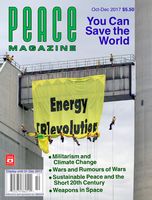
Peace Magazine Oct-Dec 2017, page 29. Some rights reserved.
Search for other articles by Sarah Neiman here
Directed by Evgeny Afineevsky, 2017 for HBO. Reviewed by Sarah Neiman.
It has been nearly two years since the body of three-year-old Aylan Kurdi washed up on a Turkish beach, the tragic end to one family’s desperate flight from war-torn Syria.
This photo of toddler Kurdi, face down in the waves, sparked anguish and a flood of compassion for refugees around the world.
More recently, however, the United States’ acceptance of Syrian refugees has become a controversial issue in American politics, especially after President Donald Trump proposed a travel ban.
While conservatives see refugees as a security threat, Cries From Syria provides overwhelming evidence to the contrary.
Directed by Evgeny Afineevsky (last year’s Oscar nominee for Winter on Fire: Ukraine’s Fight for Freedom) and narrated by Helen Mirren, this documentary revives our collective sympathy, delivering a harrowing exposť of a still-raging civil war that has left hundreds of thousands of Syrians dead and caused more than five million others to leave the country.
Syria’s history is long and complex, but Afineevsky simplifies it intricately for the screen.
The story begins with Hafez al-Assad, who was the president of Syria from 1971 to his death in 2000, when his son, Bashar al-Assad came into power, continuing in his father’s footsteps by ruling with an iron fist.
In March of 2011, peaceful protestors in Syria took to the streets after Assad’s army captured and tortured a group of teenage boys for covering their school with anti-regime graffiti. Assad’s army cracked down on the ongoing protests of citizens demanding pro-democratic reforms and civil war began.
Rather than focusing on one specific locale facing the regime’s brutality, like Feras Fayyad’s film, Last Men in Aleppo, Afineevsky uses a geographically-ranging, wide-angle narrative to show the destruction occurring in theentire country.
Travelling from Damascus to Raqqa to Homs to Aleppo, viewers witness death and destruction. From Assad’s regime putting cities and hospitals under siege with tanks, to the use of chemical weapons, and finally to Russian intervention and jihadist influence, it becomes clear to viewers that no end to this war is in sight.
Incorporating first-hand footage primarily captured by Syrian activists, ordinary citizens, and citizen journalists on their mobile devices, the film’s unbearably graphic images do not make for an easy watch.
We gaze into a gut-wrenching display of mutilated corpses, wailing infants being pulled from suffocating mounds of dust and debris, unbridled regime brutality against rebel groups like the Syrian Free Army, as well as endless explosions.
Perhaps the film’s strongest feature is the Syrian natives, young and old, who convey the experience of living in this war-ravaged nation through riveting interviews.
No longer citizens with jobs, homes, and access to education and healthcare, these people show us their current life inside Syrian borders.
“We are not terrorists—we have lovers, kids—we are people like everyone of this world, and we still have dreams,” said Kholoud Helmi, an activist.
Despite everything they have endured, they remind us that they retain a hope for freedom and a better tomorrow. The children especially show this optimism.
Serving as the backbone of the film, the director’s numerous interviews with Syria’s little ones; from their stories of having their schools bombed, to dealing with starvation, to their artwork illustrating their homeland’s demise, they make an overwhelming emotional appeal, as they innocently show the future Syrian nation as shrouded in ambiguity.
Additional input from human rights defenders and Syrian government army defectors point to the mammoth scale torture occurring inside the country, demonstrating the basic human rights being stripped from these innocent people.
Afineevsky poignantly displays Syria’s plight by delivering a heartbreaking narrative that reminds us how compassion requires the United States to open its gates.
The film does not offer any military or political solution to the largest humanitarian crisis of the 21st century, but that is not its objective. Rather, it gives these civilians a voice.
This film is not for the faint of heart. You will be tempted to look away at times. Don’t.
We owe it to not only our brothers and sisters in humanity, but little Aylan Kurdi, whose voice has been forever silenced.
Reviewed by Sarah Neiman

Peace Magazine Oct-Dec 2017, page 29. Some rights reserved.
Search for other articles by Sarah Neiman here